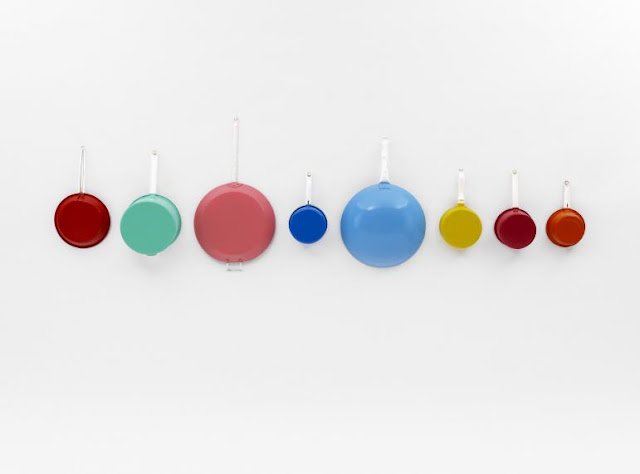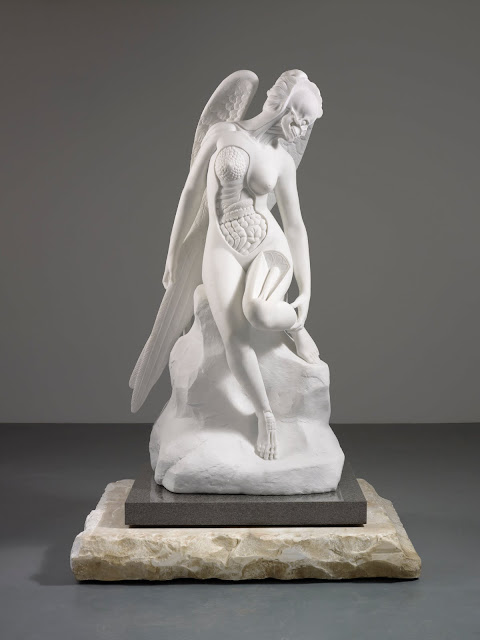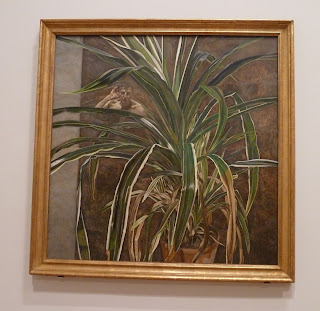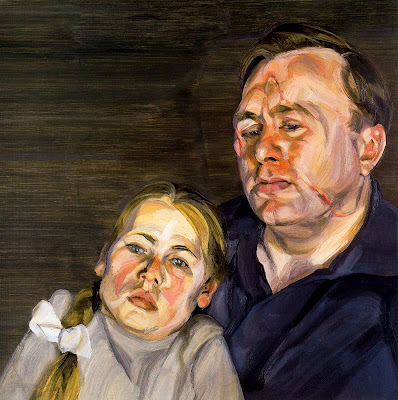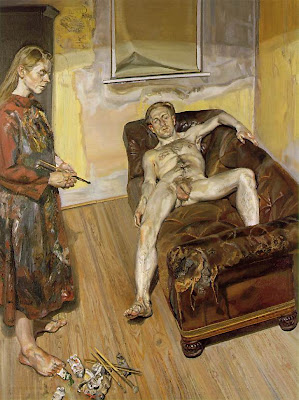Room 1
8 Pans, 1987
The
early works begin with the eight pots and pans covered in bright household
gloss that Hirst assembled whilst still at Goldsmiths. It is apparent even here
that space will quite literally occupy a delineating and central role in
typifying his work.
Never
mind the flat round bottoms of frying and sauce pans pre-empting the spot
paintings, (the first of which hangs to the left in the same room) it is
equally the case, that Damien is
obsessed with order and display. The dripping hurried look of the circles on
his first spot painting reveal far less about his emerging fastidiousness, than
the necessity to lay things out as though they are on a grid. The gaps in
between are absolutely uniform. There are tiny drips and runs on the pans, and
some of the early cases because household gloss will do that, but there is
nothing but intention and definitiveness in the scrupulous attention to
revealing space.
His
works then are not merely as many would have you believe about reconciling
painting and sculpture; they are about the techniques of both disciplines. The measuring
of perspective with pencils and brushes is not the way he arrives at his truth,
it is not even in present in the laying down of paint. It is for him merely a
way of revealing something new in the spaces in between. The early snapshot of
him posing with a nervous grin next to a dead man’s head is all too easily seen
as confirmation that the big themes he works with are life and death, but that
is true of all art. It is obviously a recurring narrative but not so insistent
as the patterns of emptiness revealed between pill boxes and butterfly wings,
the two rooms of A Thousand Years and
In and Out of Love. There is
dichotomy and tension in his examination of the permanence of death and the fleeting
brevity of life, but really it is the images that rush in and fill the vacuum
he leaves, that burn long in your brain.
Boxes, 1988
Boxes
from Freeze again reflects his
attention to order and removing chance, (with this reincarnation being even
more meticulous), but also his habit of making work specifically for spaces. In
this show he has co-opted the walls, with paper and symbols, and brought the
outside in with his butterflies and flies. He has spoken of making specifically
for spaces like the Saatchi Gallery and his arrival here in the Tate Modern does
seem somewhat overdue.
Rooms 2 & 3
The
first small medicine cabinet in this room is dwarfed by the fish swimming in
opposite directions that make up the biological naturalist Piscean species
textbook made real* in three dimensional form, and the spot painting opposite
them. The human is here breathing laboured breaths within medicine cabinets, and
the animal frozen in the two sheep heads, the lone, bleat free whole specimen and the shark and bovine figures glimpsed in the adjoining
room. Again the space between subjects is dominant, this time human and animal.
How we humanise animals and how we ironically rarely acknowledge the animalistic
truth of being Homo sapiens or “knowing
men”. This is perfectly demonstrated with Away from the flock. Here the lone sheep is made an individual
inviting us to endow it with human qualities, like personality. This is again apparent
in room 9 with the aptly named Mother and
child divided. The tenderness, with which these specimens are presented,
their pristine, washed and brushed white hairs rendered immaculately and
carefully stretched and fixed onto acrylic mounts inside the vitrines is very
touching. There is a Dove later mounted as if in flight and presented like an
angel, its vitality revered by the glistening soft feathers appearing washed by
man made detergent achieving a brightness not found in nature.
The Physical Impossibility of
Death in the Mind of Someone Living, 1991
The
shark does little to frighten or instil any sense of mortality in me, it
suffers I think from overexposure and while knowing it is not a great white you
still expect to be overwhelmed by it’s scale and menace, and yet the fear
barely breaks the surface. The ripples are not there, and only the thick glass
of the three heavy cabinets offers any distortion. The formaldehyde renders the
menace impotent. In all the tanks bubbles rise to the surface and stay frozen
in time as an impression on the glass lid. Duchamp may have sought to remove
the hand of the artist but like a sucking sock pulled out of the sand the shoe
of Hirst remains indelibly etched in these captured bubbles. The artist has
said that he liked the fishes because even in formaldehyde it was as if they
were in their natural environment, but I think the opposite is true. Water
moves and reveals the motion of creatures that move through it. Those tell tale
trails of transit are missing even when posed as if swimming.
Rooms 4
The Acquired Inability to
Escape, 1991
Here
again there is much to be found in what is missing. The lack of a smoker leaves
an indelible impression as present as the gaps between butt ends in Dead Ends Died Out. It is a kind of
poetry that reminds me more of the dulcet tones of T.S .Elliot than Francis
Bacon. A year earlier and in the previous room Hirst had made A Thousand Years the now infamous living
and dying physical embodiment of the life cycle of maggot to fly, helped along
by the severed head of a cow some sugar and water and the glowing blue scythe
of the tiny vomiting disease carriers own personal Death, the insect-o-cutor.
Here the maggots are not hidden in a box they are laid out in neatly measure
rows like the pill cabinets, each space between measured out like the breaths
of a lifetime. The seeds of decay ignited with a blue flame and resurrected
should they falter by sucking on their dry caramel innards. As I move towards
the butterflies I can hear again the voice of Eliot reading aloud his poem, The Love-Song of J. Alfred Prufrock,
And I
have known the eyes already, known them all—
The eyes that fix you in a formulated phrase,
And when I am formulated, sprawling on a pin,
When I am pinned and wriggling on the wall,
Then how should I begin
To spit out all the butt-ends of my days and ways?
The eyes that fix you in a formulated phrase,
And when I am formulated, sprawling on a pin,
When I am pinned and wriggling on the wall,
Then how should I begin
To spit out all the butt-ends of my days and ways?
Rooms 5 & 6
You
are as a visitor encouraged to move, steadily and slowly, through the live
butterflies, something I needed encouragement to do. Strangely and unexpectedly
I found myself comfortable, if a little bored by dead butterflies and unsure
about live ones. For me In and Out of
Love was a very fleeting, transient and all too brief experience to draw
many conclusions about it. Again surprise has been surgically removed from the
installation by it’s familiarity and context in such a building.
Rooms 7
The work
Pharmacy seems to lose focus at such
a scale. Ten years later in Lullaby, the
Seasons a work mounted in four cabinets in room 3 Hirst nails it in a
beautiful three dimensional evocation of his spot paintings reflected in having
colour and the spaces in between perfectly symmetrically realised whilst
incorporating the anatomical themes of his first medicine cabinet. In those he
replaces belief in pharmaceutical drugs with lullabies and the poetry of
seasons. Each season’s colour is presented almost impressionistically per
cabinet but here in Pharmacy there
seems to be no emotional presence. There may be a reference to A Thousand Years with the Insect-o-cutor
but there is none of that works surrendering of control. Here the Artists grip
is vice like and no amount of Pharmaceuticals is going to stop the patient
dying.
Room 8
The
spin paintings and a giant remaking of Room 1’s excellent What Goes Up Must Come Down in the floating beach ball of Loving in a World of Desire. Again scale
does not help and I can not engage with it as much as it’s original inception,
humble and ready made it may have been but it also creates more volume than
this industrial version. However many tins of gloss you ejaculate over a
spinning canvas you will never capture much about love and desire when your
method is so meticulous and predictable. They all look like spin paintings.
Spewing over a record deck would at least introduce unpredictable cuboid
matter. Gloss paint has been developed to give uniform results and that is
exactly what it does.
Room 9
Crematorium,
1996
Mother
and Child Divided (detail), 1993
The
exploration of the space between things and the gap between ideals is
manifested here in both cow and calf. Hirst has said that his work is about
everything and nothing and it is easy to buy this as a neat explanation for the
polar aspects of his work. The reality though seems not to be so neat. Whilst these huge mammals are neatly and
surgically torn asunder it is not merely to reveal the inside and outside, the
spiritual and the physical, the tangible and the ineffable, the soft white coat
and the dried bloodied innards. The artists invites you to once again explore
the space between these ideas. Is the cow mounted in two tanks or in one
divided? Where does the division lay? Is it between the calf now separated from
it’s mother, or in the walkway opened up between each body and traversed by the
galleries pilgrims in search of truth? Maybe the real gulf opening up here is
the distance between secular society and the Christian story of virgin birth.
From
birth we hurtle to life’s end. In the same room one’s olfactory senses are
assailed by the stench of death, but this is not the reek of abattoir, the
bovine carcasses now odourless and forever sealed in stasis. This is the
somewhat more pleasant caramel like dusty waft of cigarette ash. The huge ash
tray Crematorium is again undone by
its scale. There is too much artifice here in the choice of fags, all Marlboro
and Camel, Regals but no tobacco or cheap brands and to much neatness. No dirty
ash skid marks up the sides and a Disney like surrealism that has me expecting
the arrival of a giant slobbering dog from Honey I Shrunk The Impact .
Room 10
A
bit like an Art lesson this room feels a bit cold and desperate. The convoluted
juxtaposition of the three works Still,
Doubt and Lapdancer with the work
Trinity- Pharmacology, Physiology,
Pathology suffocates engagement. The first three bright glimmering
stainless steel cabinets, carefully laid out with surgical instruments and
implements are too busy and utilitarian, the objects crowding any sense of
space, their shiny reflective surfaces imposing on each other much more
clumsily than the tools themselves would cleft, lacerate or buttress gaping
wounds. The opposing Trinity of teaching aids in three white wooden cabinets
are all too domestic. The anatomical models and cutaway sections of wombs,
heads and uteruses reveal nothing but the workings of a body and nothing about
the artist or his reaction to anything. Like the formulated plastic it is all
very practical but the viewer is distracted by this and too enamoured with the
illustrative lessons the objects are giving than any message hidden in the art.
Room 11
The Anatomy
of an Angel, 2008
Doorways to
the Kingdom of Heaven, 2007 (detail)
Rendering
the ineffable and transient as immovable flesh rendered in Marble is nothing
new. The sculptor responsible for this angel though has realised Hirsts vision
by following directions to continuing chipping away at the white marble, long
after the languid form of one of God’s messengers has been revealed. The
renaissance style statue is peeled open like a medical teaching aid, creating
an internal anatomy of human fallibility and evoking more wonder and awe than
that engendered by a traditionally ethereal angel. Deep cavernous lines, like
heavy bold set type, and a new lexicography to an ancient art, with nods to Da
vinci and the twin Gods of religion and Science.
I am
Become Death, Shatterer of Worlds, 2006
While
Sympathy in White Major – Absolution II could
easily be transferred to the ceiling or floor of any holy building, Doorways to the Kingdom of Heaven would
make most sense transposed to the stained glass arches of a Christian chapel or
cathedral. It is a very English work suffused with a pastoral beauty and
grandeur that befits its religious overtones. It is at once, both awe inspiring,
and modest. I am become Death, Shatterer
of Worlds is hypnotic and rhythmic, it’s pulsing circular motifs beating an
eastern karmic raga of reincarnated butterflies into your brain. All three of
these works are so much more astonishing in real life, the symmetrical
application of jewelled and many hued butterflies onto canvases covered with
household gloss amounting to so much more than the sum of its parts. Yet here
in these works the space between things is the big element again, the frame
work and grid on which all his work hangs. It is a stunning tour de force which
could so easily collapse into decoration. Opposite these intertwining cogs of reincarnated
beauty, in the next room, he presents us with a massive full stop that tempers
any over exuberance, and explodes into ones consciousness.
Room 12
Black
Sun, 2004
Black
Sun, 2004 (detail)
Black Sun is like
being punched in the face by an acorn headed Ernie Shavers. It is as if Mark
Rothko had given alien birth to Guernica and the bastard fly encrusted canvas
is sucking not only your face off, but siphoning out your soul through the hot
dusty orifices of your fleshless skull. It presents death as a real and three
dimensional reality. Not an easily dismissed printed full stop or two
dimensional painting. This death is not an abstract thought, this is the real
deal, presented as the end of space, of air to breathe, of gaps in which blood
can flow and cells can move, this is the all encompassing suffocating
decomposition of stasis. An orgy of corpulent flies, their conflagration no
longer concerned with copulation, fucked but not fucking, piled up like monuments
to decay. There is a Black sheep in the room, and I notice the pleasing
blackness of its case but really I am rooted to the spot and transfixed by
Damien’s big gob. He began this journey nervously smiling next to the head of a
dead man and just thirteen years later he is howling into the abyss.
Room 13
All
this death makes Damien sick, so sick that four years later in 2008 like some
Cronenbergian nightmare, he regurgitates Lullaby,
the Seasons from 2002 as an opulent and soulless exercise with Judgement Day part of the two day
Sotheby’s two day auction project Beautiful Inside my Head Forever. I
worry about what is inside his heart at this point, because although he is
clearly still concerned with beauty he is rehashing a facsimile of pills with manufactured
diamonds and a gold cabinet. It is a curious case of Gerald Ratner inverted, in
which an obviously more luxurious and valuable yet inferior copy of something
precious is sold for millions.
Judgement
Day, 2009
Room 14
Hirst
hints at the polar opposites of life and death with The Incomplete Truth but like the Holy Spirit, this dove seems to
hover in between. It is so achingly beautiful after the ugly gold cabinet of Judgement Day, that it seems however
much Damien tries to say everything and nothing with his work, he can never
clip the wings of his own humanity. The moment is captured perfectly, rising up
in flight with tiny air bubbles of formaldehyde caught between its feathers this
symbolic bird is all about the soul, and the definition of inner space. Like a
tiny piece of heaven flying through water, its dichotomy, as a symbol of peace
and freedom, trapped forever in a glass vitrine, is a demonstration of the
invisible space between ideas that holds everything here together. Without air to
fly through it is nothing, and yet the artist’s mastery over space has freed it
even from this earthly tether, preserving it floating impossibly like a
hallmark anointing his work for all eternity.
The Incomplete Truth, 2006
* Isolated Elements Swimming in the Same
Direction for the Purpose of Understanding (Left) and (Right) 1991
